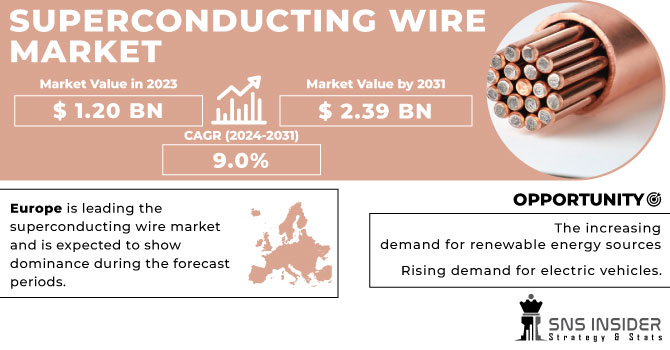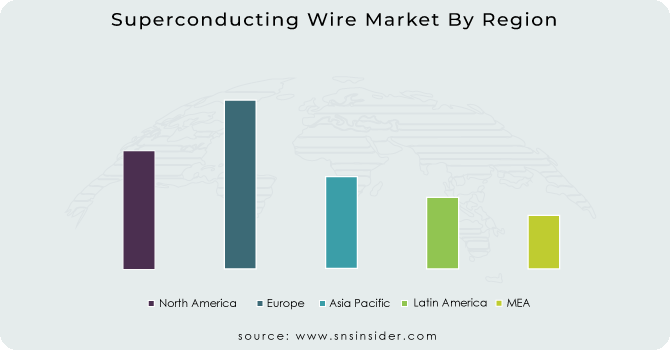Superconducting Wire Market Report Scope & Overview:
The Superconducting Wire Market size was valued at USD 1.20 billion in 2023 and is expected to grow to USD 2.39 billion by 2030 with an emerging CAGR of 9.0% over the forecast period of 2024-2031.
The superconducting wire is a type of wire that has the ability to conduct electricity with zero resistance when it is cooled to a certain temperature. This temperature is known as the critical temperature or Tc, and it varies depending on the material used to make the wire. Superconducting wire has many applications in various fields, including medicine, transportation, and energy.

To Get More Information on Superconducting Wire Market - Request Sample Report
In medicine, superconducting wire is used to create magnetic resonance imaging (MRI) machines, which are used to diagnose and treat various medical conditions. In transportation, superconducting wire is used to create magnetic levitation (maglev) trains, which can travel at high speeds without touching the ground. In energy, superconducting wire is used to create high-capacity power transmission lines, which can transport electricity over long distances with minimal energy loss.
The Superconducting Wire Market is a rapidly growing industry that has gained significant attention in recent years. The demand for superconducting wires is increasing rapidly due to their numerous advantages over traditional wires. These wires are highly efficient, which means that they can transmit electricity over long distances without any loss of energy. They are also cost-effective, as they require less energy to operate and maintain than traditional wires. In addition to their efficiency and cost-effectiveness, superconducting wires are also environmentally friendly. They produce less waste and emissions than traditional wires, making them a more sustainable option for businesses and industries.
Market Dynamics
Drivers
-
Increasing demand for energy-efficient technologies
Superconducting wires have the ability to transmit electricity with zero resistance, which makes them highly efficient. This has led to their increased use in various applications such as power generation, transmission, and distribution. This factor drives the market for superconducting wire.
-
Increasing demand for medical imaging equipment
Restrain
-
High cost associated with the production of superconducting wire.
The manufacturing process for superconducting wires is complex and requires expensive materials, which makes them costly to produce.
Opportunities
-
The increasing demand for renewable energy sources
-
Rising demand for electric vehicles.
Challenges
-
Lack of awareness about the benefits of superconducting wires
Impact of COVID-19:
The market has experienced a decline in demand due to the pandemic's effect on various industries, including healthcare, transportation, and energy. Furthermore, the pandemic has disrupted the supply chain, causing delays in the delivery of raw materials and finished products. This has led to an increase in the cost of production and a decrease in profit margins for manufacturers. However, the pandemic has also created opportunities for the superconducting wire market. The need for medical imaging equipment has increased due to the pandemic, leading to a surge in demand for superconducting wires used in MRI machines. Additionally, the demand for renewable energy sources has increased, creating opportunities for the use of superconducting wires in wind turbines and power transmission.
Impact of Russia-Ukraine War:
The conflict has disrupted the supply chain of these wires, leading to a shortage in the market. The superconducting wire market is highly dependent on the availability of rare earth metals, which are primarily sourced from China. However, due to the trade restrictions imposed by the US on China, the supply of these metals has been severely affected. This has led to an increase in the prices of rare earth metals, which has further impacted the superconducting wire market. Moreover, the conflict between Russia and Ukraine has led to a disruption in the transportation of goods, including superconducting wires. The conflict has also led to a decrease in the production of these wires, as many factories have been shut down due to the conflict.
Impact of Recession:
The global recession has had a significant impact on the superconducting wire market. This market, which is responsible for the production and distribution of wires that can conduct electricity with zero resistance, has seen a decline in demand due to the economic downturn. As a result of the recession, many industries that rely on superconducting wire have reduced their production and investment in new technologies. This has led to a decrease in demand for superconducting wire, which has had a negative impact on the market.
Key Market Segmentation
By Type:
-
Low-Temperature Superconductors
-
Medium-Temperature Superconductors
-
High-Temperature Superconductors
By End-User:
-
Energy
-
Medical
-
Research
-
Transportation
-
Others
Regional Analysis
Europe is leading the superconducting wire market and is expected to show dominance during the forecast periods. Europe has a strong focus on sustainability and renewable energy, which has led to an increased demand for superconducting wires. These wires are used in a variety of applications, including wind turbines, power grids, and medical equipment, all of which are crucial for a sustainable future. Moreover, Europe has a highly skilled workforce and a robust infrastructure that supports the growth of the superconducting wire market. This has enabled European companies to produce high-quality products at competitive prices, making them a preferred choice for customers worldwide.
The superconducting wire market is expected to experience significant growth in the coming years, with North America emerging as the fastest-growing region. This can be attributed to several factors, including the region's robust infrastructure, technological advancements, and increasing demand for energy-efficient solutions. North America boasts a well-established infrastructure that supports the development and deployment of superconducting wire technology. The region's advanced manufacturing capabilities and research facilities enable the production of high-quality superconducting wires that meet the demands of various industries. Moreover, North America has been at the forefront of technological advancements in the superconducting wire market. The region's research and development efforts have led to the creation of innovative products that offer superior performance and efficiency. This has resulted in increased adoption of superconducting wires across various industries, including healthcare, energy, and transportation. Another key driver of growth in the North American superconducting wire market is the increasing demand for energy-efficient solutions. With rising concerns over climate change and the need to reduce carbon emissions, there is a growing demand for technologies that can help reduce energy consumption. Superconducting wires offer a highly efficient solution that can significantly reduce energy loss and improve overall energy efficiency.

Do You Need any Customization Research on Superconducting Wire Market - Enquire Now
REGIONAL COVERAGE:
-
North America
-
USA
-
Canada
-
Mexico
-
-
Europe
-
Germany
-
UK
-
France
-
Italy
-
Spain
-
The Netherlands
-
Rest of Europe
-
-
Asia-Pacific
-
Japan
-
south Korea
-
China
-
India
-
Australia
-
Rest of Asia-Pacific
-
-
The Middle East & Africa
-
Israel
-
UAE
-
South Africa
-
Rest of the Middle East & Africa
-
-
Latin America
-
Brazil
-
Argentina
-
Rest of Latin America
-
Key Players
The major players are Japan Superconductor Technology Inc., Bruker Corporation, Eaton Corporation PLC, American Superconductor Corporation, Phoenix Contact, Theva Dunnschichttechnik GmbH, Furukawa Electric Co., Ltd., Fuji Electric Co., Ltd., Fujikura Ltd., Superconductor Technologies Inc., and other key players mentioned in the final report.
Bruker Corpoporation-Company Financial Analysis

| Report Attributes | Details |
| Market Size in 2023 | US$ 1.20 Bn |
| Market Size by 2031 | US$ 2.39 Bn |
| CAGR | CAGR of 9.0 % From 2024 to 2031 |
| Base Year | 2023 |
| Forecast Period | 2024-2031 |
| Historical Data | 2020-2022 |
| Report Scope & Coverage | Market Size, Segments Analysis, Competitive Landscape, Regional Analysis, DROC & SWOT Analysis, Forecast Outlook |
| Key Segments | • By Type (Low-Temperature Superconductors, Medium-Temperature Superconductors, High-Temperature Superconductors) • By End-user (Energy, Medical, Research, Transportation, Others) |
| Regional Analysis/Coverage | North America (USA, Canada, Mexico), Europe (Germany, UK, France, Italy, Spain, Netherlands, Rest of Europe), Asia-Pacific (Japan, South Korea, China, India, Australia, Rest of Asia-Pacific), The Middle East & Africa (Israel, UAE, South Africa, Rest of Middle East & Africa), Latin America (Brazil, Argentina, Rest of Latin America) |
| Company Profiles | Japan Superconductor Technology Inc., Bruker Corporation, Eaton Corporation PLC, American Superconductor Corporation, Phoenix Contact, Theva Dunnschichttechnik GmbH, Furukawa Electric Co., Ltd., Fuji Electric Co., Ltd., Fujikura Ltd., Superconductor Technologies Inc. |
| Key Drivers | • Increasing demand for energy-efficient technologies |
| Market Opportunities | • The increasing demand for renewable energy sources • Rising demand for electric vehicles. |

